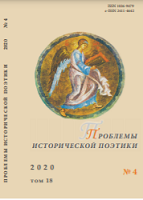История о Кайсе и Любне в средневековом арабском фольклоре
The Romance of Qays and Lubnā in Medieval Arabic Folklore
Author(s): Arzu SadykhovaSubject(s): Customs / Folklore, Studies of Literature, Middle Ages, Islam studies
Published by: Петрозаводский государственный университет
Keywords: Qays ibn Ḏarīḥ; Lubnā; oral tradition; the ‘Uḏrī love storу; preIslamic love story; early Muslim literature; pre-Islamic Arabic literature;
Summary/Abstract: Medieval Arabic literature is rich in love stories about Bedouin poets who lived in pre-Islamic and Islamic times. By the end of the 9 century AD, these tales have formed an independent genre that followed certain aesthetic principles and norms. One of these stories - the romance of Qays ibn Ḏarīh ̣ and his beloved Lubnā - is unique, for it has a number of unusual features, including two versions of an ending - tragic and happy. This article attempts to trace the process of the story formation to clarify the reason for the existence of two ending versions and discuss its other peculiarities. The study has revealed that the romance of Qays and Lubnā has a pre-Islamic prototype - the tale of ‘Abdallāh Ibn al-‘Ağlān and Hind. Traces of this version survived in the romance of Qays and Lubnā, which is rooted in the oral tradition: it combines the elements of the old primitive unhappy lovers canon (a marriage, then a divorce under family pressure, separation, suffering and death) and the new model - the ‘Uḏrī love story that appeared after the rise of Islam as a reaction to new aesthetic values that cultivated chaste love. As the political disagreements emerged in Islam and the role of Šī‘a Islam increased, a number of new details and a happy end were added to the story (very likely in 8 century AD), reflecting the philosophical contradictions between Sunnī and Šī‘a Islam. These points have determined the uniqueness of the story about Qays ibn Ḏarīḥ and Lubnā among other ‘Uḏrī love stories.
Journal: Проблемы исторической поэтики
- Issue Year: 18/2020
- Issue No: 4
- Page Range: 38-66
- Page Count: 29
- Language: Russian

